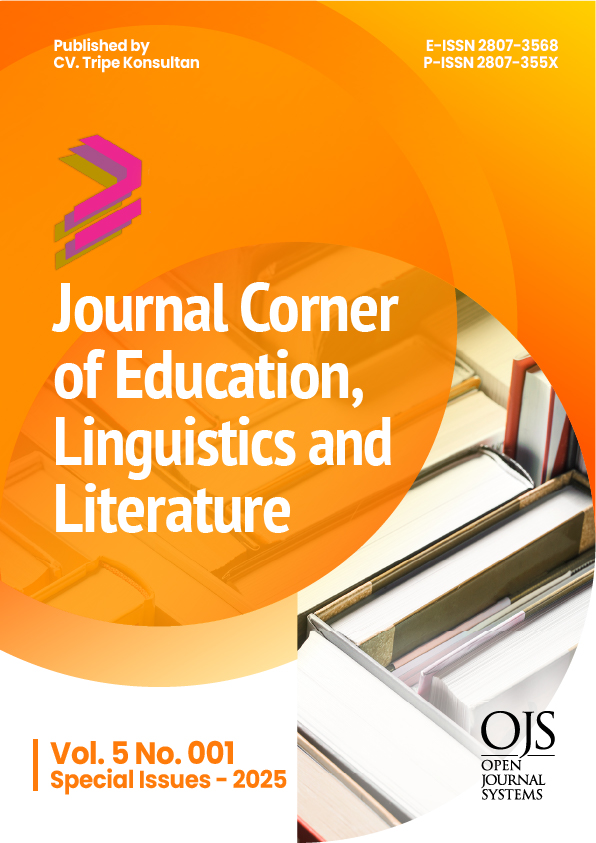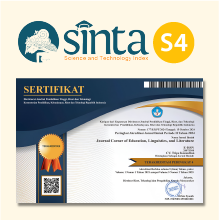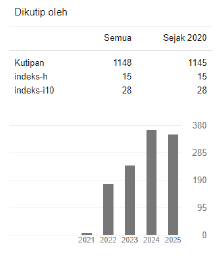Contrastive Analysis Between English and Indonesian Suffix
 https://doi.org/10.54012/jcell.v5i001.633
https://doi.org/10.54012/jcell.v5i001.633
 Abstract views: 101
Abstract views: 101
 PDF downloads: 48
PDF downloads: 48
Keywords:
Contrastive Analysis, English Suffix, Indonesian Suffix, MorphologyAbstract
Language serves as a vital instrument for human interaction, allowing individuals to convey thoughts, feelings, and ideas with clarity and nuance. Words, as the fundamental building blocks of language, are often modified through morphological processes like affixation, which includes the addition of prefixes and suffixes. This research seeks to examine and compare the suffixes used in English and Indonesian, with particular attention to their forms, meanings, and functions. Employing a qualitative descriptive methodology, the research drew on authoritative sources such as grammar textbooks, dictionaries, and scholarly linguistic publications. Through contrastive analysis, it identified both the similarities and distinctions between the two languages' suffix systems. The findings revealed that English and Indonesian suffixes share commonalities in word formation and grammatical modification, enabling the creation of nouns, verbs, adjectives, and adverbs, as well as conveying abstract concepts, professions, or ideologies, for instance, the English suffixes -ness and -ment correspond to the Indonesian -an, while English -ism aligns with Indonesian -isme. Nonetheless, notable differences emerge; English suffixes like -ly, -ward, and -wise often denote manner or direction, whereas Indonesian suffixes such as -kan, -i, and -pun typically express actions, directions, or inclusiveness. This research underscores the pivotal role of suffixation in morphological development, facilitating semantic shifts and grammatical transformations. It also illuminates both structural similarities and language-specific features, offering valuable insights for language education, learning, and further morphological investigation.
Downloads
References
Al-Rickaby, A. (2023). The survival of contrastive analysis hypothesis: A look under the hood. Theory and Practice in Language Studies, 13(1), 1-7.
Amalia, D. F. (2013). Contrastive analysis on English and Indonesian prefixes and suffixes in the narrative texts of student’s textbooks for senior high school (Skripsi). STAIN Salatiga.
Cici, J. L., & Sarwita, T. (2022). Survei Tingkat Persepsi Guru Dan Orang Tua Terhadap Pembelajaran Daring (Dalam Jaringan) Selama Pandemic Covid 19 Pada Sma 1 Baitusalam Aceh Besar. Jurnal Ilmiah Mahasiswa Pendidikan, 3(2).
Collins, P., & Hollo, C. (2017). English grammar: An introduction. London: Bloomsbury Publishing.
Departemen Pendidikan dan Kebudayaan. (2017). Tata bahasa baku bahasa Indonesia (Edisi ke-4). Jakarta: Depdikbud.
Hutajulu, F. S. L., & Herman, H. (2019). Analysis of illocutionary act in the movie “You are my home” English subtitle. JEES: Journal of English Educational Study, 2 (1), 29–36.
Kazemian, B., & Hashemi, S. (2014). A Contrastive Linguistic Analysis of Inflectional Bound Morphemes of English, Azerbaijani and Persian Languages: A Comparative Study. Journal of Education & Human Development, 3(1), 593-614.
Kamal, R. N., Jrew, R. A., Al-Rikabi, E. W. A., & Mohammed, A. M. (2025). Semantic Roles of English Language Teaching Derivational Suffixes. Manar Elsharq Journal for Literature and Language Studies, 3(1), 14-21.
Khansir, A. A., & Pakdel, F. (2019). Contrastive analysis hypothesis and second language learning. Journal of ELT research, 4(1), 35-43.
Mena, V. V., & Saputri, K. (2018). A contrastive analysis between English and Indonesian prefixes and suffixes in the descriptive texts of student’s textbooks. English Community Journal, 2(1), 175-182.
Nedjar, D. (2025). Contrastive linguistics for language acquisition and learning: An analytical study. International Journal of Innovative Technologies in Social Science, 2(46), 1–9. https://doi.org/10.31435/ijitss.2(46)1-9.2025.3381
Oranga, J., & Matere, A. (2023). Qualitative research: Essence, types and advantages. Open Access Library Journal, 10(12), 1-9.
Rahmi, L., & Ifadloh, N. (2022). AN ANALYSIS OF AFFIXATION IN FAIRY TALE “THE FROG KING, OR IRON HENRY” BY JACOB AND WILHELM GRIMM. Proceeding Stai Rakha Amuntai, 1(1), 138-148.
Sari, A. A. N., & Nufus, Z. (2022). An Analysis of Inflectional Affixes in Short Story “Rumpelstiltskin” By The Brothers Grimm. Proceeding Stai Rakha Amuntai, 1(1), 169-180.
Sitompul, S. J., Pratama, A., Zuhri, A., & Aripin, N. (2021). Interferensi Morfologi Bahasa Aceh dalam Tulisan Bahasa Indonesia Mahasiswa Universitas Teuku Umar. Journal of Social and Policy Issues, 17-21.
Syamsuddin, N., Simbolon, G. A. H., Surni, S., Gani, R. A., Bugis, H., Towe, M. M., Guntur, M., Maulidah, S., Taufik, M., Presty, M. R., & Pitri, A. D. (2023). Dasar-dasar metode penelitian kualitatif. Selat Media Patners. https://hamjahdiha.or.id
Zainuddin. (2016). A Study on Derivational Affixes of Indonesian Noun-Formation in Newspaper Editorial: A Semantic Perspective. International Journal of English Linguistics, 6(3), 148-155.
Downloads
Published
How to Cite
Issue
Section
License
Copyright (c) 2025 Veronika Marlina Rosari Silalahi, Selviana Napitupulu, Mungkap Mangapul Siahaan

This work is licensed under a Creative Commons Attribution-ShareAlike 4.0 International License.
All articles published in the Journal Corner of Education, Linguistics, and Literature are licensed under the Creative Commons Attribution-ShareAlike License (CC BY-SA).

















